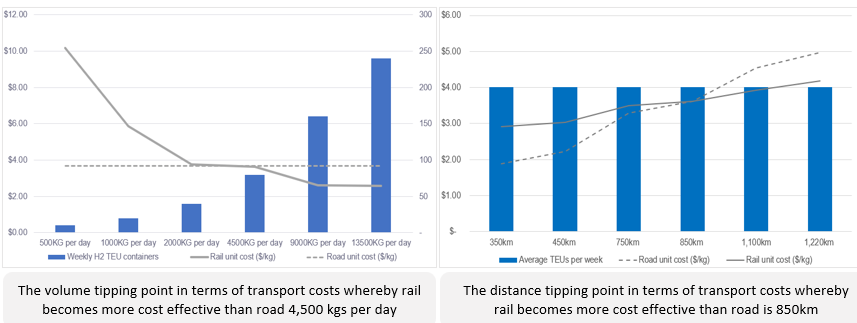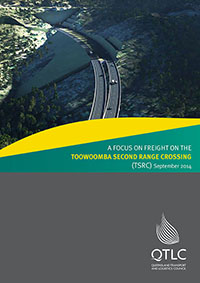QTLC
Queensland Transport and Logistics Council
Our vision is to be the agent for Queensland’s freight sector, acting as an industry advisory body to government on supply chain policy and freight investment and infrastructure issues in Queensland.

Road Transport
Road is the predominant mode for the transportation of freight in Queensland.

Rail Transport
The advantages of rail are its capacity and economies of scale.

Maritime Transport
Shipping carries 99% of Australia’s total international trade by mass and tonne/km’s and 75% by value.

Air Transport
The advantages of air transport are fast transit times and high quality of service.

Intermodal
Intermodal freight terminals are the points within the land based supply chain where non bulk freight are transferred between different modes of transport.
Vision & Values
The QTLC is a cooperative industry and Government advisory body that provides advice to industry stakeholders on the development, planning, regulation and operation of freight and logistics transport, infrastructure and services in Queensland.
The Council’s objectives are to:
- Promote the efficiency and development of the freight transport and logistics industry in Queensland, including the movement of goods to urban, intrastate, interstate and overseas markets across all modes of transport; and
- Facilitate improved efficiency and integration of freight transport infrastructure throughout the freight logistics chain.
The Council will do this by identifying issues impacting on the State’s freight movements as raised by industry and Government, exchanged views as to the means of progressing resolution of those issues and then determine a solution which can form the basis of advice given in an objective and holistic manner to industry and the Government.
Our Mission
The Queensland Transport and Logistics Council’s Mission is to represent the freight transport and logistics industry to influence policy, regulation, infrastructure planning and investment to achieve sustainable and productive supply chains.
The QTLC aims to support the efficient movement of freight in order to support sustainable and productive economic development and prosperity.
The QTLC achieves this by pursuing:
- Appropriate and ongoing investment in supply chain infrastructure;
- Integrated regional and urban planning frameworks that secure land for current and future freight corridors;
- An access policy and regulation environment that facilitates productivity and innovation; and,
- Efficient integration and linkage of freight and logistics systems across the whole supply chain.
Latest QTLC News
Queensland 2024/25 Chickpea Transportation: Issues and Solutions
September 2024
QTLC has worked with the supply chain to understand and share knowledge in the issues faced. With industry, we have articulated a range of proactive productivity levers and collaborative solutions to ensure we capitalise on, and all share in the associated economic oppotunity.

Supporting QEJP Wind Farm Transportation – a review of Oversize Overmass Wind Farm Arrangements

Transport of Hydrogen by Rail
In 2022, QTLC worked with a set of stakeholders interested in the emerging hydrogen economy to understand transportation of gaseous hydrogen by rail.
In particular, the study looked at volumes and distances in which hydrogen transportation by rail would be advantageous and what safety and regulatory barriers exist for this to occur. Funded by the Australian Government’s Inland Rail Interface Improvement Program, the proposal was conceptual in nature – but based on a theoretical route of Toowoomba to Parkes in tanktainers.
The detailed report contained a number of findings which will be of interest not just to hydrogen industry proponents, rail operators and/or intermodal operators.

Sustainable Freight
As Zero Emission Vehicles (ZEVs) emerge as a step change for Queensland’s trucking and freight industry, QTLC is working with the sector to explore the challenges and opportunities in transitioning to Zero Emission (ZE) trucks. This project engaged with fleets from across Queensland spanning many freight types as well as OEMs to understand the challenges they face in a transition to ZE trucks.
This report considers the current market for ZE trucks in Australia, the market potential to 2025, and the factors that are constraining growth as well as those that would enable it. The analysis considers the technical, economic, and cultural elements associated with purchasing ZE trucks. It also considers the influence of freight customers and corporate social responsibility drivers for change.
The paper finds that in 2025 (or before) battery electric trucks can be technically and economically viable in several applications.
Importantly, the work provides a series of recommendations for various stakeholder groups in the road freight ecosystem to accelerate the transition to ZE Trucks.
This analysis from the project is presented in the following report:

Series of Reports: A Focus on Freight
As Queensland seeks to increase economic competitiveness in the global marketplace, it is critical we have a freight system that supports resilient, effective and efficient supply chains, and which can meet the current and future demands.
To that end, the QTLC has undertaken an analysis of the global supply chain characteristics and policy imperatives driving economic development and growth, to understand how these relate to proposed and existing infrastructure. In summary, QTLC’s objective is to Better understand supply chains in Queensland, the drivers of change, and the policy and infrastructure requirements to support future growth.
This analysis from the project is presented in three reports, focusing on:

Future Freight in Queensland
This examines the major Queensland supply chains, global supply chain trends, policy imperatives and freight infrastructure. Eleven of Queensland’s major supply chains are detailed through Supply Chain Perspectives, with this information informing subsequent investigations.

The Toowoomba Second Range Crossing (TSRC)
Using information derived from the Supply Chain Perspectives and an Industry Forum, this report provides an examination of the supply chain benefits, freight efficiency opportunities and broader economic opportunities provided by the TSRC.

Queensland’s Inland Highway
This report identifies a resilient inland freight route connecting South East Queensland to northern Australia and to the key nodal infrastructure that supports Queensland’s major supply chains.




